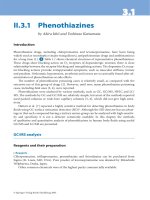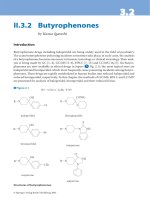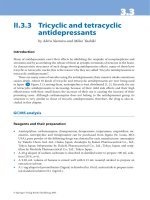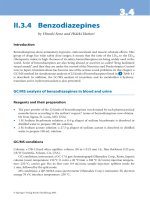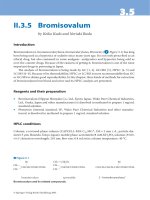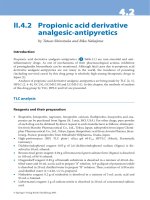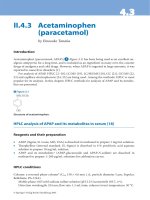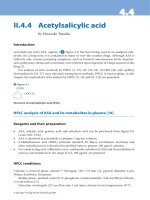Tài liệu Drugs and Poisons in Humans - A Handbook of Practical Analysis (Part 39) ppt
Bạn đang xem bản rút gọn của tài liệu. Xem và tải ngay bản đầy đủ của tài liệu tại đây (336.76 KB, 8 trang )
4.74.7
© Springer-Verlag Berlin Heidelberg 2005
II.4.7 β-Blockers
by Makoto Ueki
Introduction
β-Blockers ( β-adrenergic receptor antagonists) block the e ects of catecholamines on signal
transmission through β-receptors; they cause hypotension by decreasing the heart beat rate
and cardiac output, and prevent the attacks of arrhythmia and angina pectoris. In the brain, the
drugs attenuate migraine by suppressing the dilation of blood vessels; in the eye, they decrease
intraocular pressure by suppressing the production of aqueous humor. Since the drugs are also
e ective in suppressing muscle quivering and in suppressing overreaction of the thyroid gland
upon being too nervous, they are used as doping drugs in competitive sports such as shooting
and archery, which require psychic powers of concentration rather than aerobic performance.
As untoward e ects of these drugs, chill of extremities due to the contraction of vessels and
aggravation of bronchial asthma due to contraction of the bronchi can be mentioned.
e drugs can be classi ed into β
1
- and β
2
-blockers; the β
1
-receptors are mainly located in
the heart muscle, while the β
2
-receptors located in the smooth muscles of the airways and
blood vessels. e β
1
-blockers speci cally exert blocking action on the β
1
-receptors; otherwise,
the β-blockers act on both β
1
- and β
2
-receptors.
e β-blockers are structurally classi ed into isopropylamino drugs such as propranolol
and tertiary butylamino drugs such as nadolol; and many products containing 26 kinds of
β-blockers are commercially available in Japan. e metabolism of β-blockers depends upon
the hydrophobicity of their side chain structures. e drugs with hydrophilic side chains, such
as atenolol, labetalol and nadolol, are excreted into urine in unchanged forms, while the drugs
with hydrophobic side chains are excreted into urine in the glucuronide-conjugated forms a er
their hydroxylation. erefore, it is almost di cult to detect unchanged forms of drugs from
urine for such hydrophobic β-blockers. e concentration ratio of a metabolite to its precursor
drug in urine and the location to be hydroxylated in a drug structure are di erent according to
races and individuals; care should be taken especially when the foreign literature is searched on
the metabolism of β-blockers.
HPLC analysis
Reagents and their preparation
• Many of the authentic standards of β-blockers can be purchased from Sigma (St. Louis,
MO, USA); when compounds are not commercially available, they were directly obtained
from their manufacturers with request. Ethyltheophylline
a
, to be used as internal standard
(IS), is synthesized by heating theophylline (Sigma) and twice-molar ethyl iodide at 60 °C
overnight in acetone in the presence of potassium carbonate. Other common chemicals
used were of the highest purity commercially available
370 β-Blockers
• Solid carbonate bu er: the powder of sodium carbonate is mixed with a half-weight of the
powder of sodium bicarbonate, and the mixture is well ground in a mortar and stored in
a dry state
• IS solution: ethyltheophylline is dissolved in methanol to prepare 100 µg/mL solution
• Mobile phases for HPLC: mobile phase A, acetonitrile/phosphoric acid/distilled water
(15:0.1:85, v/v); mobile phase B, acetonitrile/phosphoric acid/distilled water (60:0.1:40, v/v).
HPLC conditions
Separation column: Nucleosil7C
18
(250 × 4.6 mm i. d., Macherey-Nagel, Düren, Germany).
HPLC conditions; instrument: L-6200 type
b
(Hitachi Ltd., Tokyo, Japan); autosampler:
WISP 714 plus (Waters, Milford, MA, USA); ow rate: 1.5 mL/min. Gradient elution is linearly
made from 100 % A to 100 % B during 8 min a er injection. Detector: HP1040DAD (Agilent
Technologies, Palo Alto, CA, USA); detection wavelengths: 216, 254 and 275 nm, because of
low speci city of the detection by ultraviolet absorbance.
Procedure
i. A 1-mL volume of a specimen, 50 µL IS solution (containing 5 µg ethyltheophylline) and
0.5 g of solid carbonate bu er are placed and mixed well in a glass centrifuge tube with a
ground-in stopper, followed by the addition of 5 mL diethyl ether and gentle shaking for
5 min.
ii. A er centrifugation at 1,000 g for 5 min, the ether phase is transferred to a vial and evapo-
rated to dryness under a stream of nitrogen.
iii. e residue is dissolved in 300 µL methanol and a xed aliquot of it is injected into
HPLC
c
.
iv. Blank specimens are spiked with various concentrations of the authentic standard of a drug
and the IS, and are processed according to the above procedure to construct each calibra-
tion curve. By applying the peak area ratio of a specimen to the calibration curve, the
concentration of a target compound is calculated.
Assessment of the method
> Figure 7.1 shows HPLC chromatograms for atenolol, nadolol and labetalol extracted from
urine of their users. Atenolol is eluted just a er the void volume; however, since it has a couple
of asymmetric carbon atoms in its structure and produces two peaks due to the isomers, its
identi cation is relatively easy. Nadolol could be detected until about 7 h a er single adminis-
tration, but it has no characteristic absorbance maximum and lacks in speci city; it should be
careful to identify nadolol by HPLC. e detection limit of the β-blockers was about 100 ng/
mL (10 ng on-column).
371
Simultaneous GC/MS analysis of β-blockers
and their metabolites [1–3]
Reagents and their preparation
• Acquisition of the authentic standard drugs and their preparation are the same as described
in the HPLC analysis section
• 1 M Phosphate bu er solution (pH 7.0): a 34.0-g aliquot of potassium dihydrogenphos-
phate is dissolved in distilled water, followed by adjustment of the solution to pH 7.0 with
10 M NaOH; then the nal volume is adjusted to 250 mL
•
Solid carbonate bu er: the powder of sodium bicarbonate is mixed with a half-weight of potas-
sium carbonate powder, and the mixture is well ground in a mortar and stored in a dry state
• Derivatization reagents: N-methyl-N-(trimethylsilyl)tri uoroacetamide ( MSTFA) and
N-methyl-bis(tri uoroacetamide) ( MBTFA) were purchased from Macherey-Nagel
(Düren, Germany)
• IS solution
d
: bupranolol is dissolved in ethanol to prepare 0.2 mg/mL solution.
GC/MS conditions
Instrument
e
: HP-5970MSD (Agilent Technologies)
GC column: Ultra-II (12.5 m × 0.25 mm i. d., lm thickness 0.33 µm, Agilent Technologies)
HPLC chromatograms for β-blockers extracted from urine of subjects, who had ingested each of
them. The results were obtained after single oral intake of each drug. In the analysis of atenolol,
double peaks appeared for this drug, because of two asymmetrical carbon atoms present in its
structure.
⊡ Figure 7.1
Simultaneous GC/MS analysis of β-blockers and their metabolites
372 β-Blockers
Flow rate: 1 mL/min (about 20 kPa/cm
2
of He pressure at 100 °C); injection temperature:
300 °C; split ratio = 11:1; sample volume to be injected: 2 µL; ionization mode: EI; electron
energy: 70 eV; ion multiplier: auto tune + 300 V
e range in the scan mode: m/z 50–600; dwell time of each ion in the SIM mode: 30 ms/
ion. e measurements are made for the following 3 groups by switching them according to
retention times.
Ion group 1: from 2.5 min of retention time
m/z 86, 129, 200, 284, 365, 373, 427, 478, 479, 505, 526 and 559
Ion group 2: from 5.1 min of retention time
m/z 86, 129, 235, 250, 284, 344, 348, 421, 448, 478, 488, 497, 510 and 526
Ion group 3: from 6.0 min of retention time
m/z 86, 91, 129, 284, 292, 478 and 515.
Procedure
i. A 5-mL volume of urine, 50 µL IS solution (containing 10 µg bupranolol), 1 mL of 1 M
phosphate bu er (pH 7) and 30 µL of β-glucuronidase K-2 (3 nuits, Roche Diagnostics
GmbH, Mannheim, Germany) are placed in a glass centrifuge tube with a ground-in stop-
per, and incubated at 50 °C for 60 min for hydrolysis.
ii. e hydrolyzed solution is mixed with 5 mL diethyl ether and gently shaken for 5 min for
washing the aqueous phase. A er removal of the organic phase, 1 mL 2-methylpropanol
and about 0.1 g of solid carbonate bu er are added to the aqueous phase and mixed well.
iii. A 5 mL volume of diethyl ether
f
and 3 g anhydrous sodium sulfate are added to the above
aqueous phase, gently shaken for 20 min and centrifuged at 1,000 g for 5 min. e resulting
ether phase is transferred to a glass vial with a screw cap and evaporated to dryness under
a stream of nitrogen.
iv. e residue is dissolved in 50 µL MSTFA, followed by heating at 50 °C for 5 min a er cap-
ping the vial for TMS derivatization. A er cooling to room temperature, 15 µL MBTFA is
added to the mixture, followed by heating at 50 °C for 15 min for TFA derivatization. Since
the reactions are dependent upon equilibrium, the reaction solution should not be evapo-
rated, but directly injected into GC/MS.
v. e calibration curves are constructed for quantitation in the same way as that of HPLC
analysis.
Assessment and some comments on the method
> Figure 7.2 shows an example of mass chromatograms of GC/MS for the extract of urine,
into which β-blockers and their metabolites had been spiked. In the automatic searching
system of the author, the presence or absence of a β-blocker is displayed a er calculating
the expected retention time of a candidate drug from the actually measured retention time
of IS and the relative retention time of the compound listed in
> Table 7.1. Isopropylamino
β-blockers and their metabolites, such as alprenolol, oxprenolol, metoprolol, atenolol,
propranolol and acebutolol, can be detected in mass chromatograms at m/z 284 and 129
373
(> Fig. 7.2). By examining a pattern (abundance ratios among diagnostic ion traces) of a mass
spectrum of a compound, it is easy to discriminate a target compound from a impurity peak.
e tertiary butylamino β-blockers are simultaneously detected by mass chromatography at
m/z 86; the β-blockers with characteristic structures, such as sotalol and labetalol, can be de-
tected with high sensitivity using their proper ions.
e detection limit of β-blockers obtained by mass chromatography of GC/MS is about
10 ng/mL (about 150 pg on column), while that by HPLC was 100 ng/mL (10 ng on-column).
> Table 7.1 summarizes the names of β-blockers and their metabolites detected, the struc-
tures of derivatives, relative retention times to that of IS, molecular weights of derivatives and two
representative fragment ions each, obtained from urine extracts of volunteers, who had received
single oral administration of each β-blocker under informed consent. e metabolites hydroxy-
lated at the aromatic rings followed by its glucuronide conjugation are found in common with
most β-blockers; especially for alprenolol, metoprolol, penbutolol and propranolol, the amounts
of metabolites to be excreted into urine are larger than those of their unchanged forms.
⊡ Table 7.1
Indicators for GC/MS analysis of β-blockers
β-Blocker Compound(s)
to be detected
Derivatization Relative
retention
time*
M. W. Monitor ions
(m/z)
acebutolol acebutolol
acetylacebutolol
N-TFA-O-TMS
N-TFA-O-TMS
2.313
2.196
504
476
284
284
129
129
alprenolol hydroxyl aprenolol N-TFA-bis-O-TMS 1.618 505 284 505
atenolol atenolol N-TFA-bis-O-TMS 1.630 559 284 559
betaxolol betaxolol N-TFA-O-TMS 2.039 475 284 129
bisoprolol bisoprolol N-TFA-O-TMS 2.027 493 284 129
carteolol carteolol bis-O-TMS 1.871 436 235 421
celiprolol celiprolol bis-O-TMS 1.643 450 86 200
esmolol esmolol N-TFA-O-TMS 1.871 448 284 448
labetalol labetalol
(racemic mixture)
nitril-N-TFA-bis-O-TMS
nitril-N-TFA-bis-O-TMS
2.442
2.476
550
550
292
292
91
91
levobunolol levobunolol O-TMS 1.792 363 86 348
metoprolol hydroxyl metoprolol N-TFA-bis-O-TMS 1.793 523 284 478
mepindolol mepindolol bis-N, N-TFA-O-TMS 1.781 526 284 526
nadolol nadolol tris-O-TMS 1.970 525 86 510
oxprenolol oxprenolol
hydroxyl oxprenolol
N-TFA-O-TMS
N-TFA-bis-O-TMS
1.278
1.160
433
521
284
284
129
129
penbutolol hydroxyl penbutolol N-TFA-bis-O-TMS 1.797 451 86 250
pindolol pindolol N-TFA-bis-N,O-TMS 2.061 488 284 488
propranolol hydroxyl propranolol
4- hydroxyl propranolol
N-TFA-O-TMS
N-TFA-O-TMS
1.708
2.148
427
515
284
284
427
515
sotalol sotalol N-TFA-bis-N,O-TMS 1.851 512 344 497
timolol timolol O-TMS 1.627 388 86 373
IS bupranolol N-TFA-O-TMS 1.000 439 86
* Relative retention time: retention times of each compound, when that of IS is assumed as 1.000.
Simultaneous GC/MS analysis of β-blockers and their metabolites
